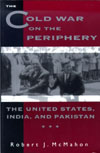|
|
|
|
by Robert J. McMahon

Focusing on the two tumultuous decades framed by Indian independence in 1947 and the Indo-Pakistani war of 1965, The Cold War on the Periphery explores the evolution of American policy toward the subcontinent, and analyzes the motivations behind America's pursuit of Pakistan and India as strategic Cold War prizes. McMahon also examines the profound consequences--for U.S. regional and global foreign policy and for South Asian stability--of America's complex political, military, and economic commitments on the subcontinent.
McMahon argues that the Pakistani-American alliance, consummated in 1954, represented a monumental strategic blunder. Secured primarily to bolster the defense perimeter in the Middle East, the alliance increased Indo-Pakistani hostility, undermined regional stability, and led India to seek closer ties with the Soviet Union. Through its examination of the volatile region across four presidencies, this book addresses questions about the global reach of postwar American foreign policy. Why, McMahon asks, did developing regions become objects of such intense concern? How did the national security interests become so expansive that they embraced nations on the Third World periphery? And what combination of economic, political, and ideological variables best explains the motives that led the United States to seek allies in virtually of every corner of the planet?
McMahon's lucid analysis of Indo-Pakistani-American relations powerfully reveals how U.S. policy was driven, as he puts it, "by a series of amorphous--and largely illusory--military, strategic, and psychological fears" about American vulnerability that not only wasted American resources but also plunged South Asia into the vortex of the Cold War.
About the author.
The Cold War On The Periphery: the United States, India and Pakistan